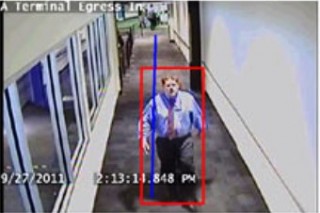Transition Task at CLE: The Student Perspective
The ALERT project VAST (Video Analytic Surveillance Transition) is an effort that addresses the needs of the TSA to monitor and mitigate threats by individuals to airport security. ALERT and the TSA Ohio Senior Federal Security Director put together a team of researchers from three COE partner universities (NEU, BU and RPI) and TSA practitioners to develop and transition solutions to “in-the-exit” and “tag and track” issues at Cleveland Hopkins International Airport (CLE). The VAST team also has an industrial partner, Siemens Corporate Research, to guide the technology transition into markets, and to lead the design and development of a testbed at CLE.
In an effort to educate the next generation of researchers, the COE partner universities have also brought on students to the teams. Tom Hebble, a student participating from Northeastern University explains, “We travel to Cleveland every week in order to install the software and collect results. Currently there are three universities working on this, and every week someone from one of the three is in Cleveland. Their job is to install the latest revision of their code, as well as collect the results from the previous week’s test, so every few weeks we’re getting a new revision out there and a few weeks of data to look at and analyze.” As stated by Post-doctoral researcher Mohamed Elgharib of Boston University, “Even though I’ve been in research for almost 4 years, ALERT was the first industry-like experience that I’ve been through. I’ve learned how to create a product that satisfies a wider community of end-users, rather than just satisfying a narrow community.” Ziyan Wu of Renssellaer Polytechnic Institute explains, “before this project, I wrote my code just to implement specific functions and make things work. This is the first time I’ve needed to seriously think about user experience, that is, I need to make my software user friendly and easy to understand. This software will be used for security surveillance, so I really need to ensure its reliability and robustness”.
Here, students realize that they are not just trying to solve a problem, they need to completely conquer it. That is to say that the algorithm developed needs to be applicable to every circumstance without exception or limitation. According to Binlong Li of Northeastern University, “it’s precious industry experience that is a big plus for newly graduated students. We are able to understand how a real project works and is developed in the industrial world. We get a good sense of how to transfer research techniques into real applications”. As Wu continues, “I understand that all research should originate from reality. It has to be rooted in the reality, serve the reality, and then enhance the reality”.
As Hebble closes, “it’s an experience of going through the design cycle of coming up with a new revision, looking at the results, making corrections, and seeing that cycle of looking at the results to find problems and coming up with new ways to solve them. This is a good experience from that standpoint, to get real hands-on design experience as well as the experience with the code.”


There are currently no comments.
The comments are closed.